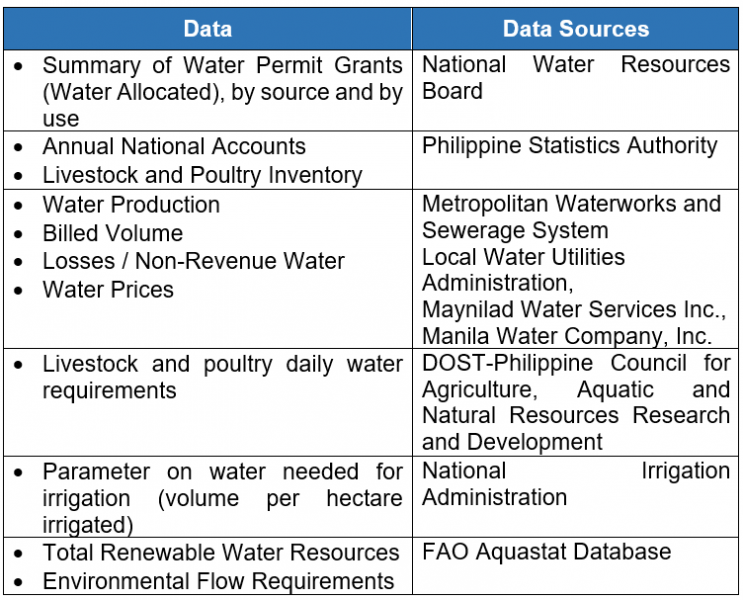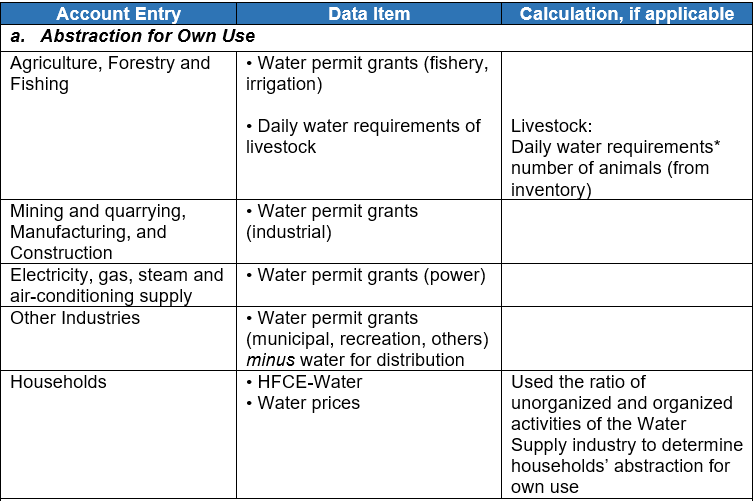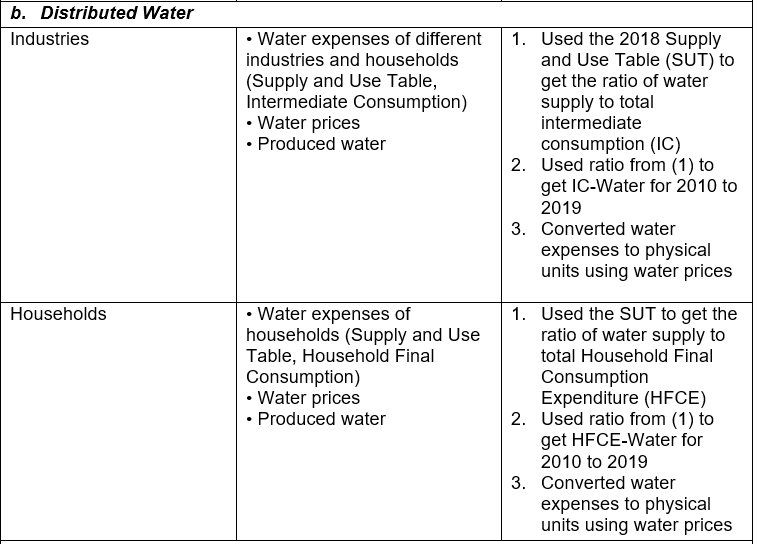I. Conceptual Framework
The Water Accounts of the Philippines is a publication presenting the physical flow accounts for water resources in the country. This is an update of the preliminary accounts released in a progress report last January 2019.
The System of Environmental-Economic Accounting (SEEA) Central Framework serves as the framework for this study. It is a multipurpose conceptual framework that quantitatively describes the interaction between the environment and the economy. Through this framework, environmental and economic data are organized to produce integrated information for policy use.
The SEEA Central Framework discusses three main accounts:
(1) the stocks and the changes in stocks of environmental assets;
(2) the economic activity and transactions related to the environment; and
(3) the flows of resources within the economy and between the economy and the environment, which is the main focus of this study for water resources.
The physical flow accounts for water resources describe the flow of water to and from the environment and the economy, covering the entire process of water supply and use–from the initial abstraction of water from the environment into the economy, to the flows within the economy done by the different industries and households, and finally, return flows from the economy back to the environment. The flow accounts are divided into two parts: the supply table (Annex 1) and the use table (Annex 2).
The flow accounts also provide the inputs to calculate SDGs 6.4.1 Change in Water Use Efficiency and 6.4.1 Level of Water Stress. These two indicators focus on the amount of water abstracted and used to carry out various economic activities.
II. Data Sources
The data for estimating the physical flow accounts and the related SDG indicators were obtained from the following:

III. Estimation Methodology of the Accounts and Indicators



SDG Indicators
The following indicators are derived following the steps outlined below.
a. 6.4.1 - Water Use Efficiency
1. From the National Accounts of the Philippines, compute the gross value added (GVA) of the following major sectors:
a) Irrigated agriculture (irrigated crops, livestock and poultry, aquaculture, support activities)
b) Mining and Quarrying, Manufacturing, Electricity and Steam, Construction (MIMEC)
c) Water Supply, Sewerage and Waste Management, Services
2. For each industry, divide the GVA by the volume of water used to calculate the water use efficiency (WUE). This excludes water for hydropower generation as this is non-consumptive use.
3. Get the weighted average WUE, using the volume of water as the weights.
b. 6.4.2 - Level of Water Stress
1. From the Water Flow Accounts, determine the Total Freshwater Withdrawals (TFWW). This excludes water for hydropower generation as this is non-consumptive use.
2. From the FAO Aquastat Database, get the Total Renewable Water Resources (TRWR) and Environmental Flow Requirements (EFR) for the Philippines.
3. The level of water stress is computed as:

IV. Definition of Terms
Abstraction - the amount of water that is removed from any source, either permanently or temporarily, in a given period of time.
Consumptive Use of Water - the part of water withdrawn from its source that will not become available for reuse.
Distributed Water - abstracted water received from other economic units, particularly from the Water Supply industry.
Evaporation of abstracted water - the amount of evaporation when water is distributed between economic units after abstraction (e.g. during distribution via open channels or while in water storage).
Groundwater - water collected in porous layers of underground formations, known as aquifers, which yield significant quantities of water to wells and springs
Losses - volume of water lost between the point of abstraction and a point of use
Non-consumptive use of water - water remains in or is immediately returned to the point of extraction and is still available for use.
Returns - the total volume of water that is returned to the environment by economic units
Reused water - wastewater supplied to a user for further use with or without prior treatment, excluding the reuse (or recycling) of water within economic units
Soil water - water suspended in the uppermost belt of soil or in the zone of aeration near the ground surface.
Surface water - this covers all water that flows over and is stored on the ground surface, which includes water in artificial reservoirs, lakes, rivers and streams, and glaciers, snow, and ice.
Transpiration - the amount of soil water absorbed by cultivated plants and subsequently released to the atmosphere.
Water Stress, Level of - the ratio between total freshwater withdrawn by all major sectors and total renewable freshwater resources, after taking into account environmental water requirements.
Water Use Efficiency - the value-added of a given major sector divided by the volume of water used.
Wastewater - water that is discarded and is no longer required by the owner or user.
Sources:
UN System of Environmental-Economic Accounting 2012 Central Framework;
UN Food and Agriculture Organization (FAO) SDG Indicators 6.4.1 and 6.4.2 Metadata
V. Dissemination of Results and Revision
The Water Flow Accounts is released annually in the PSA website. The web release materials include press release and statistical tables.
The current publication focuses only on surface water and groundwater abstraction. Due to data unavailability, soil water and other sources such as desalinated seawater, harvested rainwater, and reused water are yet to be included in future publications.
In addition, due to limited data on wastewater collection & treatment and reuse of water, return flows of water are estimated using industry parameters or water-use coefficients from international sources.
VI. Citation
Philippine Statistics Authority. (30 September 2020). Technical Notes on 2010 – 2019 Water Flow Accounts.
https://psa.gov.ph/system/files/enrad/1.%2520Press%2520Release.pdf
VII. Contact Information
Ms. Virginia M. Bathan
Chief Statistical Specialist
Environment and Natural Resources Accounts Division
(632) 8376-2041
enrad.staff@gmail.com
For data request, you may contact:
Knowledge Management and Communications Division
(632) 8462-6600 locals 839, 833, and 834
info@psa.gov.ph
